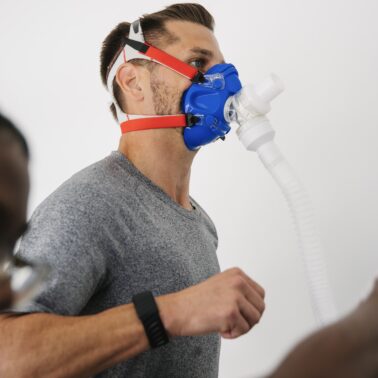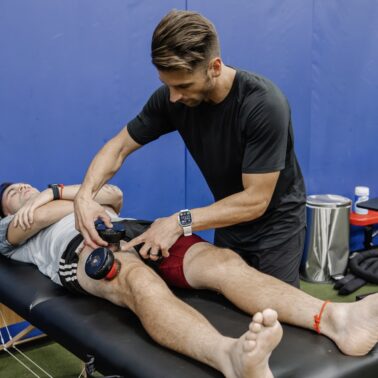“Injury recovery and rehabilitation can be challenging and a long road. Helping athletes find their small wins and have strong mental resilience can have a tremendous effect on the outcome.”
Adam Loiacono
What You Will Learn
- Understand the importance of including sports psychologists in the recovery process.
- Offer techniques for setting goals and teach readers how to help athletes create and maintain a positive outlook through journaling.
- Learn about creating an environment that fosters resilience in the face of setbacks.
Introduction
As a physical therapist who has worked extensively in the realm of professional sports, I have seen firsthand the critical role mental resilience plays in injury rehabilitation. Let’s talk about some ways to incorporate mind health and mental resilience within the injury recovery process.
The Link Between Mind and Body
The connection between mental health and physical recovery cannot be overstated. In my career, I’ve observed that athletes who approach rehabilitation with a positive mindset tend to recover more quickly and effectively than those who do not. This is not just anecdotal; there’s a growing body of research supporting the idea that psychological factors play a significant role in sports injury recovery.
Mental Resilience Defined
Mental resilience in the context of injury rehabilitation refers to the ability of an athlete to cope with the stressors and emotional challenges that come with being sidelined due to injury. It involves maintaining a positive attitude, setting realistic goals, and displaying grit and determination throughout the recovery process.
In this particular article “The Role of Optimism and Psychosocial Factors in Athletes Recovery From ACL Injury: A Longitudinal Study,” which discusses the influence of optimism on the injury recovery process. This study examined the relationships between optimism, psychosocial factors, rehabilitation adherence, and perceived knee function up to 12 months post anterior cruciate ligament (ACL) surgery. It found that pre-surgery optimism had a significant overall indirect effect on perceived knee function at 12 months post-surgery. The study highlights the importance of optimism and mental resilieance in recovery outcomes following ACL surgery.
The Role of Mental Resilience in Rehabilitation
Coping with Emotional Stress
When an athlete faces injury, the abrupt halt in their training and competition schedules can evoke an emotional response. The athlete’s identity is often intertwined with their sport; an injury may feel like a loss of self. This emotional rollercoaster can range from frustration and anger to a sense of loss. Mental resilience comes into play as the stabilizing force amidst this emotional storm. It involves adopting coping strategies such as:
- Acceptance: Recognizing and accepting the injury as a temporary phase in their sporting life.
- Emotional Expression: Providing athletes with a safe space to express their feelings can facilitate emotional processing.
- Positive Reframing: Encouraging athletes to view the injury as an opportunity for growth or to develop other aspects of their physical performance or skills in their game.
- Stress Reduction Techniques: Implementing relaxation practices like deep breathing exercises, recovery modalities, or recommending professional help can mitigate stress levels.
Goal Setting and Motivation
Goal setting provides structure and clarity to the rehabilitation journey. The act of writing the goal, thinking about the goal, and seeing the goal can have a subtle yet significant impact. These goals are not just markers of physical progress but also psychological milestones that offer continuous motivation. Here’s how goal setting aids resilience:
- Journaling: Keeping a rehabilitation journal can be a therapeutic outlet and a practical tool. Writing down goals and reflecting on the recovery process helps maintain a positive outlook. It is also an opportunity to highlight other positive things the athlete endures within their day beyond the physical rehabilitation. I have seen athletes write down references to family, hobbies, or other interests that help them stay positive even if they have a tough rehab day.
- Visible Progress: Documenting progress, even in small increments, can be incredibly uplifting and reinforce an athlete’s motivation. It allows them to see the journey they are on and in moments of difficult times, they can reflect back and witness the progress they have made.
- Adaptive Goals: Sometimes goals must be adjusted in response to recovery speed. Resilient individuals adapt their goals without losing sight of their long-term aspirations.
Overcoming Setbacks
Injuries often come with unpredictable complications or slower-than-expected progress, leading to setbacks. The recovery process is often a non-linear journey with ups & downs along the way. Here are two ways to help your athletes overcome setbacks:
- Expect and Accept Setbacks: Understanding that setbacks are a normal part of recovery can reduce frustration when they occur. Acknowledge them when they happen. Name it and move on.
- Support Networks: Leaning on coaches, fellow athletes, friends, and family for support can also provide emotional buoyancy during challenging times. Sometimes your voice becomes redundant. Another voice or perspective is sometimes what the athlete needs beyond what your help.

In long term rehab cases, I will often text the image above to the athlete. The YELLOW line shows what we all want rehab to be. The BLUE line is the realistic journey of what rehab is. Naming this from the start helps sets expectations and manage emotions.
Adherence to Rehabilitation Programs
The monotonous nature of rehabilitation exercises can sometimes lead to decreased motivation. Mental resilience is crucial for athletes to remain committed to their rehab program, particularly when progress seems to stall. Strategies to enhance adherence include:
Routine and Structure: Establishing a set routine can help athletes integrate rehab into their daily lives, making it a non-negotiable part of their schedule. During the rehab process, I will often times keep the first 10 minutes of the session the same to facilitate routines and structure.
- Variety in Exercises: Introducing variety within the constraints of the rehabilitation protocol to keep the program engaging.
- Mental Rehearsal: Using visualization to mentally rehearse rehabilitation exercises can improve both engagement and performance. One way I do this is having the athlete perform basic exercises with their eyes closed.
- Rewards: Setting up a system of rewards for adherence can offer additional motivation to stick with the program. Sometimes I will owe them push-ups or other times I will intentionally add “extra” work at the end of the session. Then I remove that “extra” work as a reward if they are able to complete all the other portions of rehab.
By reinforcing mental resilience through these strategies, athletes can navigate their rehabilitation with a stronger psychological foundation, which not only aids in their current recovery but also prepares them for any future challenges.
Strategies for Building Mental Resilience
Professional Psychological Support
The role of sports psychologists and mental health professionals is pivotal in the rehabilitation of athletes. These specialists can:
- Provide Tailored Mental Training: Equip athletes with specific psychological strategies such as therapy, stress management techniques, and relaxation methods.
- Facilitate Emotional Recovery: Help athletes work through the emotional challenges of injury, from the initial response to injury to the return-to-play phase.
- Enhance Coping Mechanisms: Teach athletes how to develop and implement effective coping strategies that can improve their ability to deal with the psychological demands of injury and recovery.

Social Support
The social environment of an athlete can significantly influence their rehabilitation process. Social support from coaches, teammates, family, and friends offers:
- Emotional Support: A network of individuals who provide empathy, care, and concern, which can help reduce feelings of isolation and depression during recovery.
- Informational Support: Advice and guidance from knowledgeable sources that can help athletes make informed decisions about their rehab and future.
- Instrumental Support: Practical help with everyday tasks or responsibilities, especially when the injury limits the athlete’s mobility or independence.
Journaling
Journaling is a powerful tool for athletes in long-term rehab, as it:
- Encourages Reflection: Enables athletes to reflect on their recovery process, articulate feelings, and acknowledge progress.
- Fosters Optimism: By focusing on small wins and positive experiences, journaling can cultivate an optimistic outlook that research has linked to better recovery outcomes.
- Tracks Progress: Offers a tangible record of improvement and challenges, which can be useful for both the athlete and the medical team overseeing the rehabilitation.
Education
Knowledge about the injury and the recovery process can empower athletes, as it:
- Demystifies the Recovery Process: Reduces uncertainty and helps athletes understand the typical timelines and stages of recovery.
- Informs Decision Making: Athletes who are educated about their condition can make better decisions in collaboration with their healthcare providers.
- Promotes Active Participation: Understanding the purpose behind each aspect of rehabilitation can encourage athletes to take an active role in their recovery.
Celebrate the small wins
Recognizing even the smallest advancements can have a large impact on an athlete’s mental state:
- Boosts Morale: Celebrating milestones can turn a routine rehabilitation session into a motivating event that reinforces commitment to the recovery process.
- Encourages Positive Reinforcement: Each small win acts as a positive reinforcement, highlighting the progress made rather than the distance still to go.
- Enhances Motivation: Small wins can be instrumental in transforming a potentially negative perspective (“I am still far from my best”) into a more positive one (“I am closer to my goal than I was yesterday”).
By incorporating these elements into the rehabilitation strategy, athletes are not only more likely to recover physically but are also equipped to handle future challenges with increased psychological resilience. These strategies can transform the rehabilitation experience from a daunting obstacle into an opportunity for personal development and growth.
Conclusion
The journey of injury rehabilitation is as much mental as it is physical. As a physical therapist, encouraging mental resilience is a key component of my approach to treatment. By sharing these insights and integrating them into rehabilitation programs, we can not only aid in the physical recovery of athletes but also empower them with skills that will serve them well beyond their return to sport.



